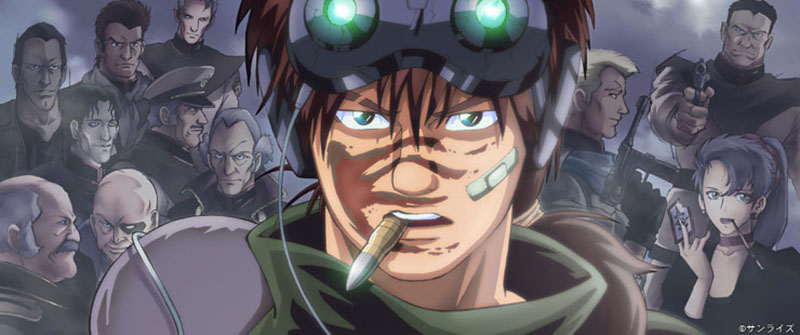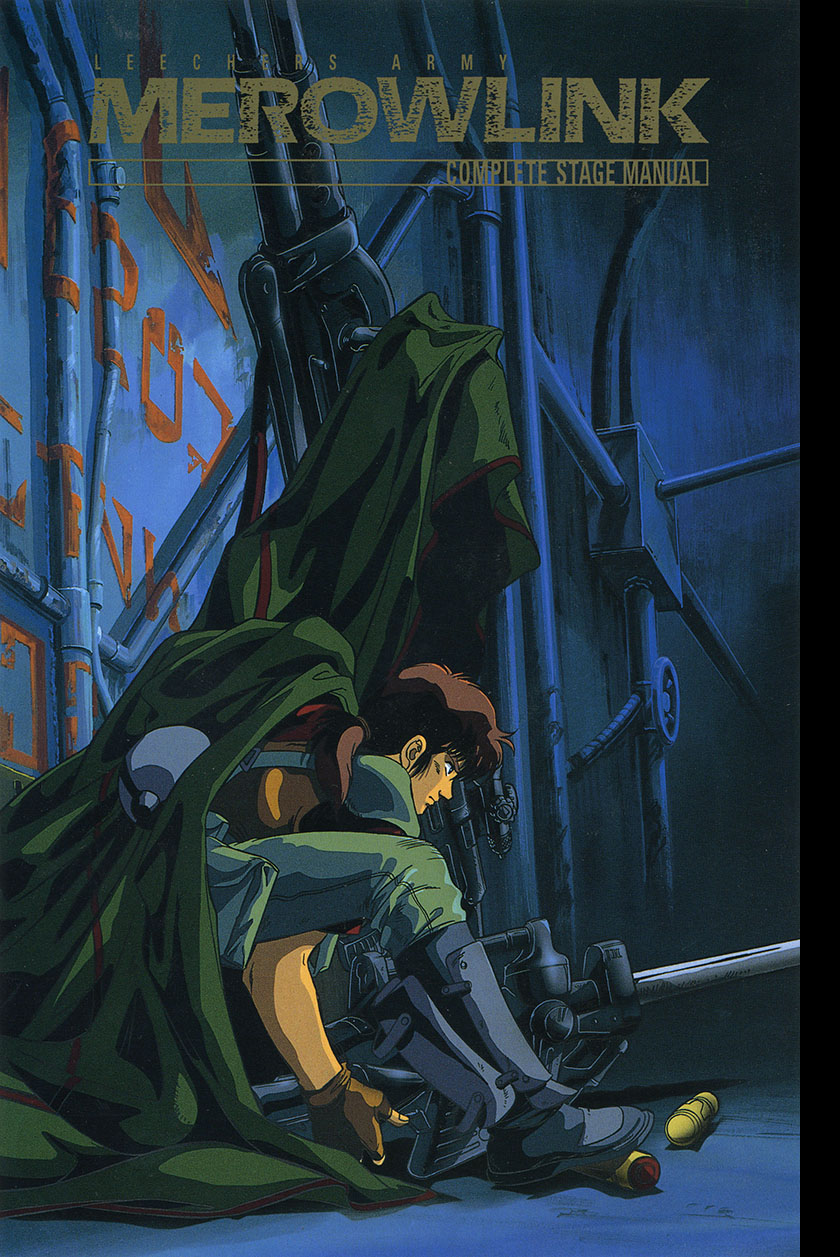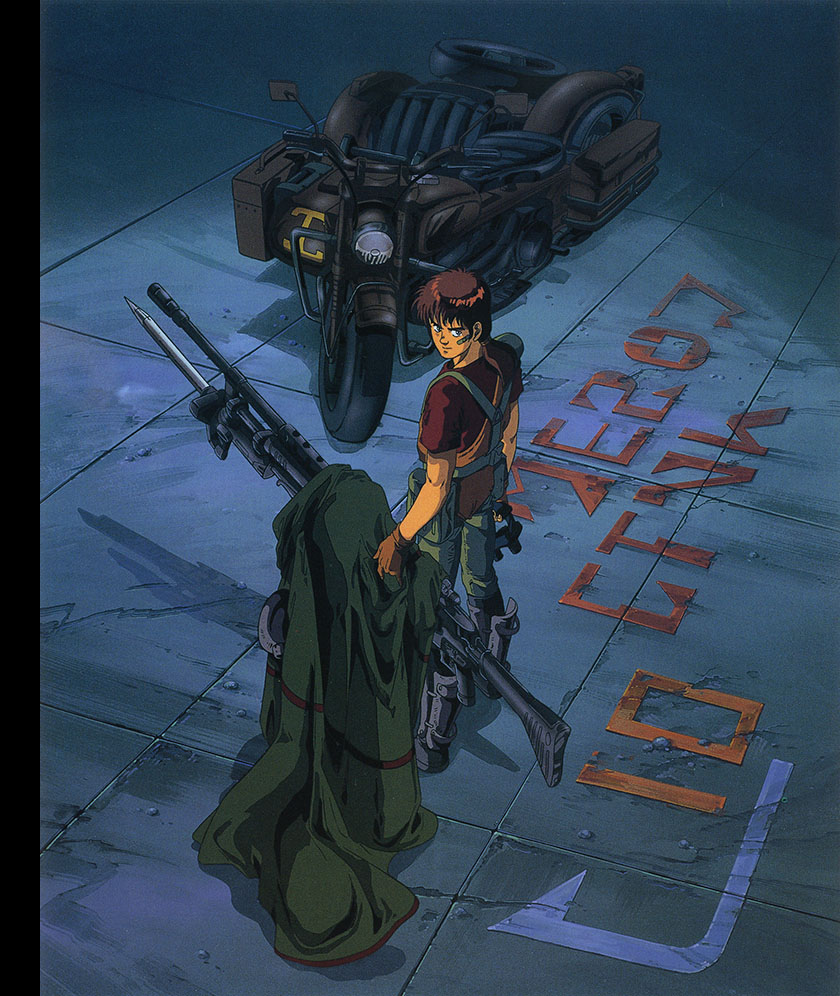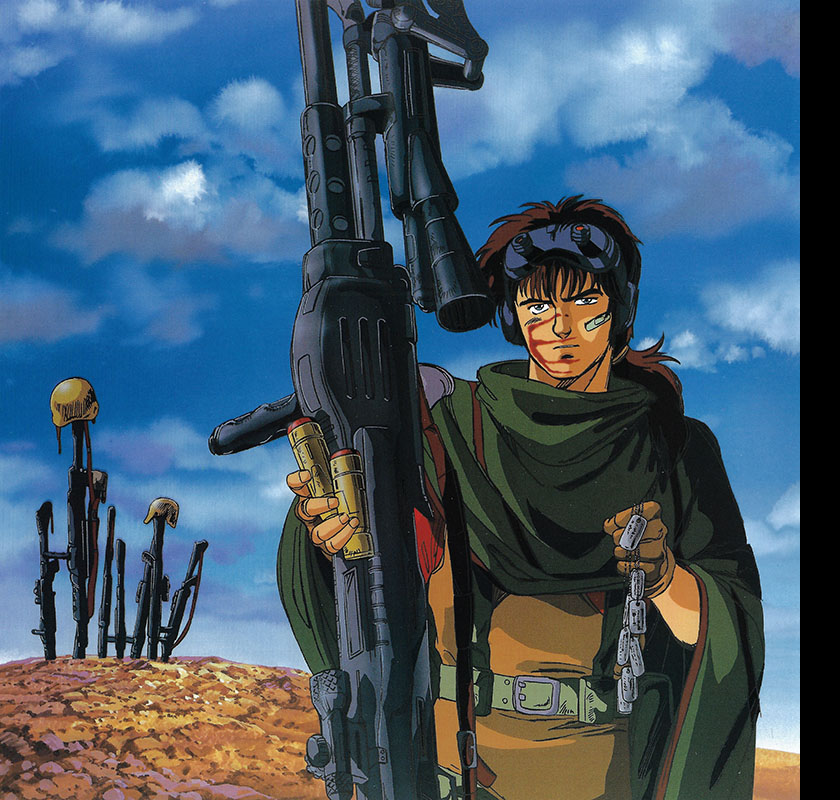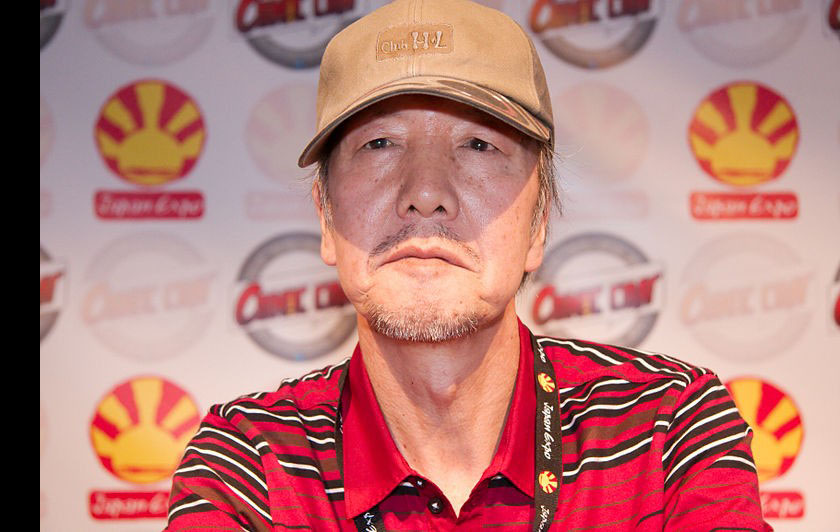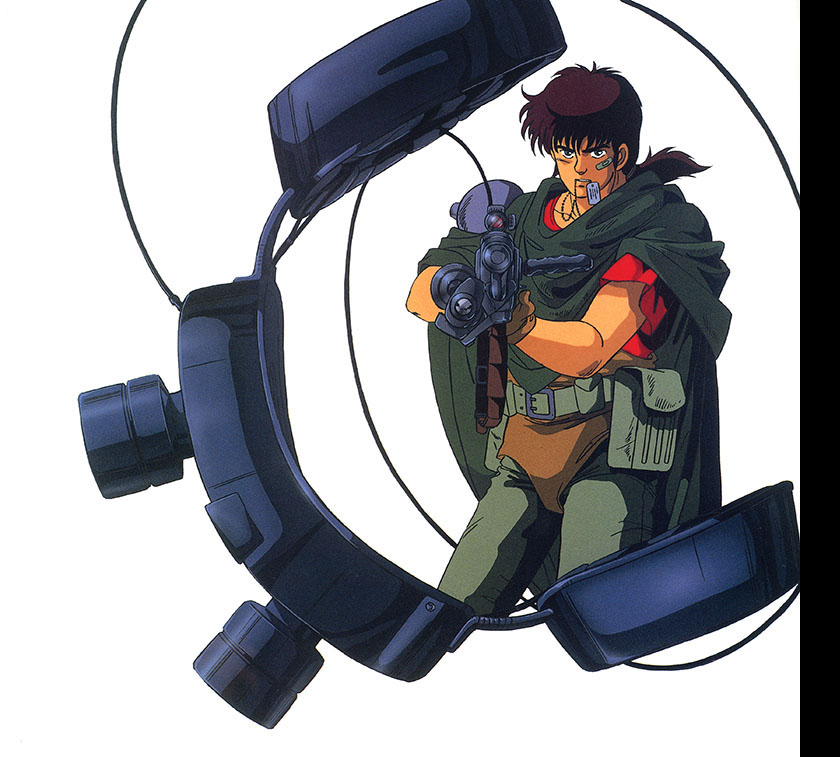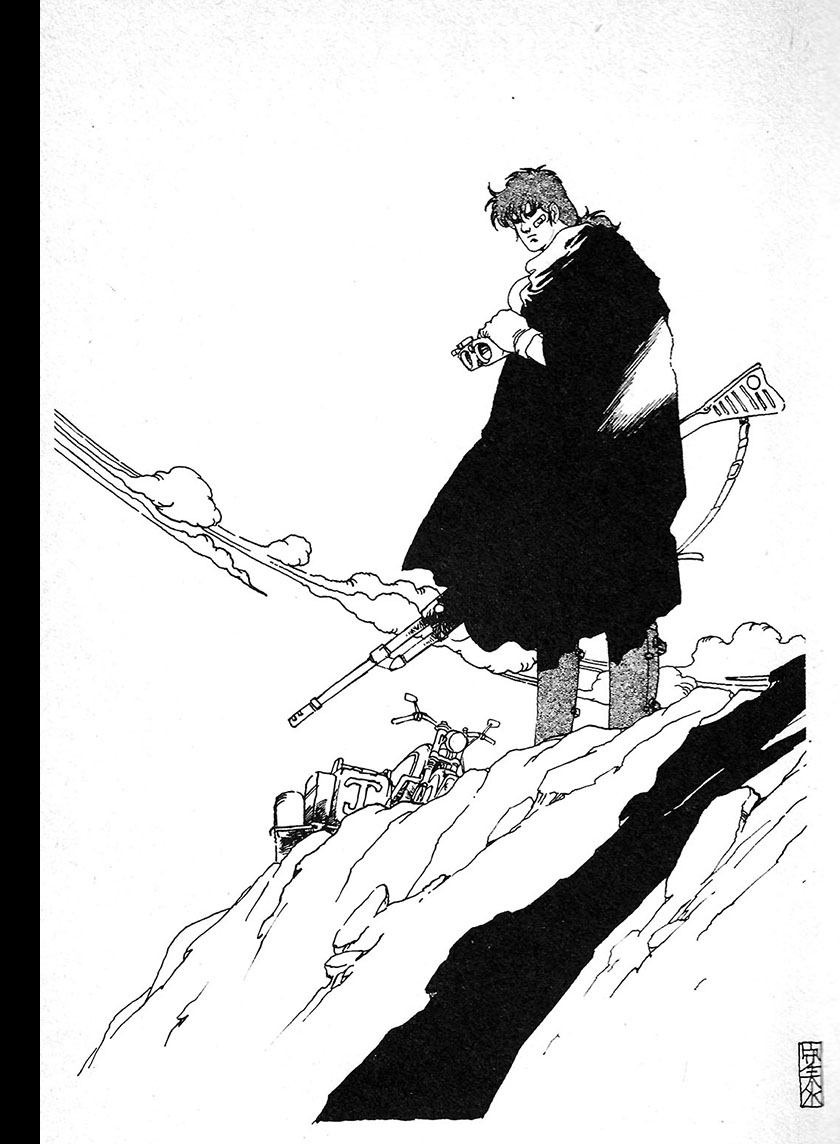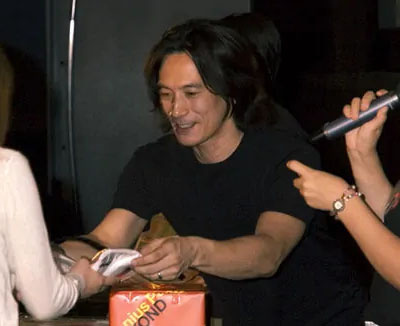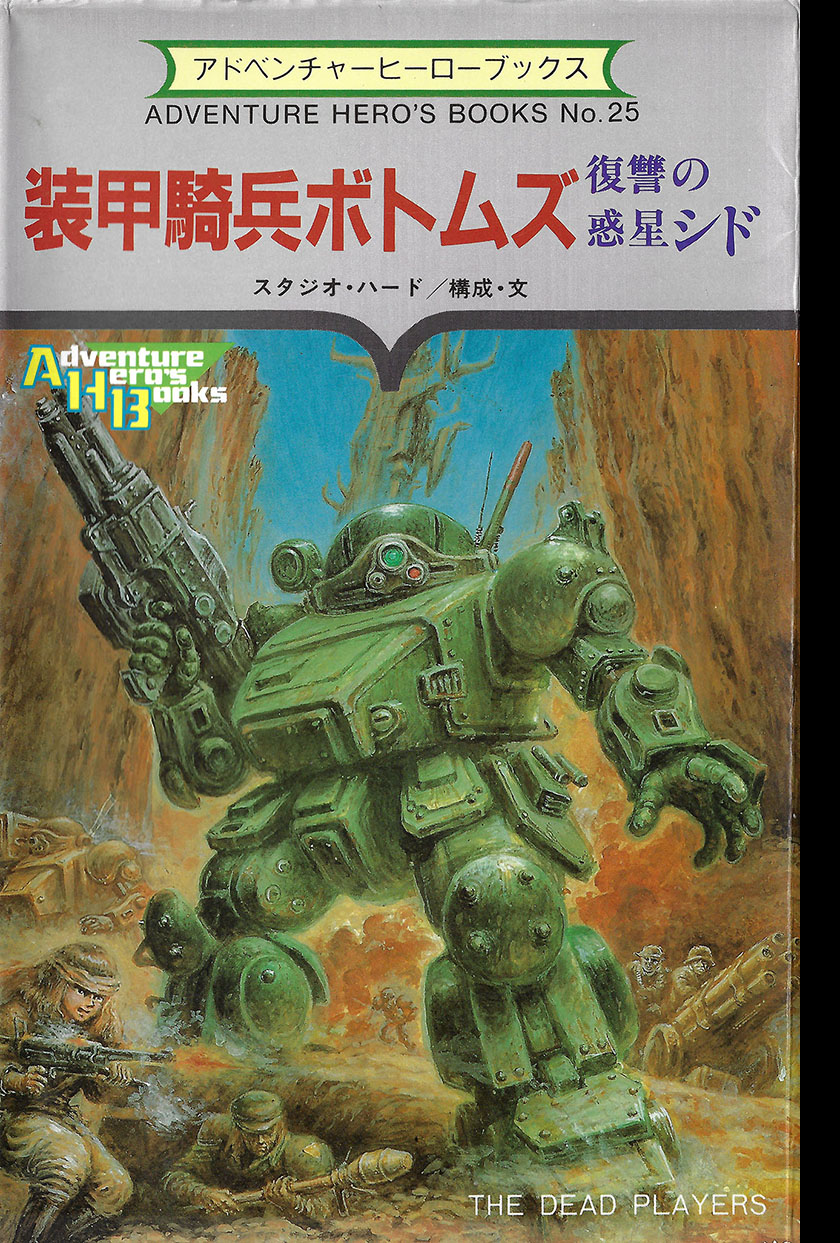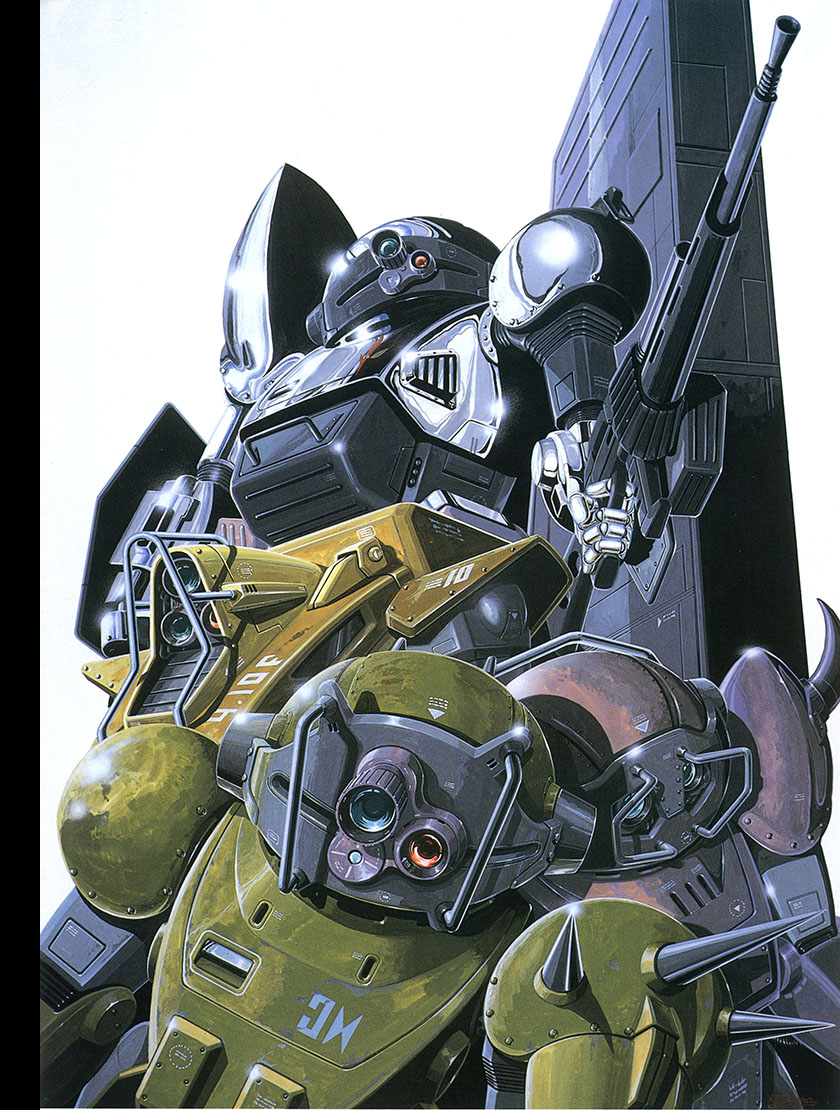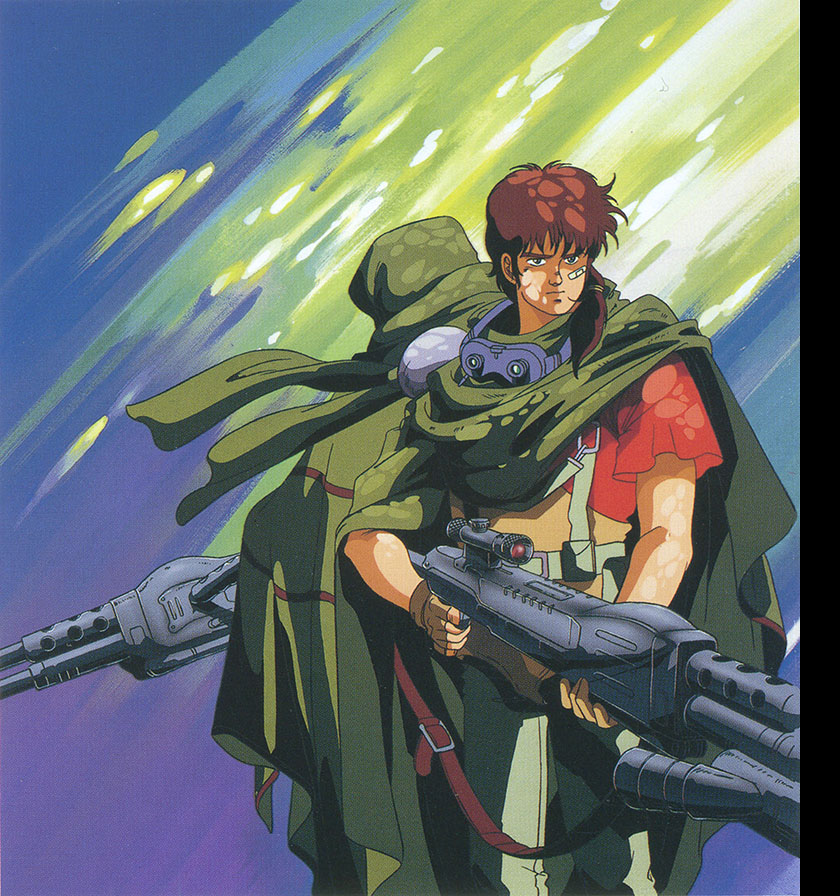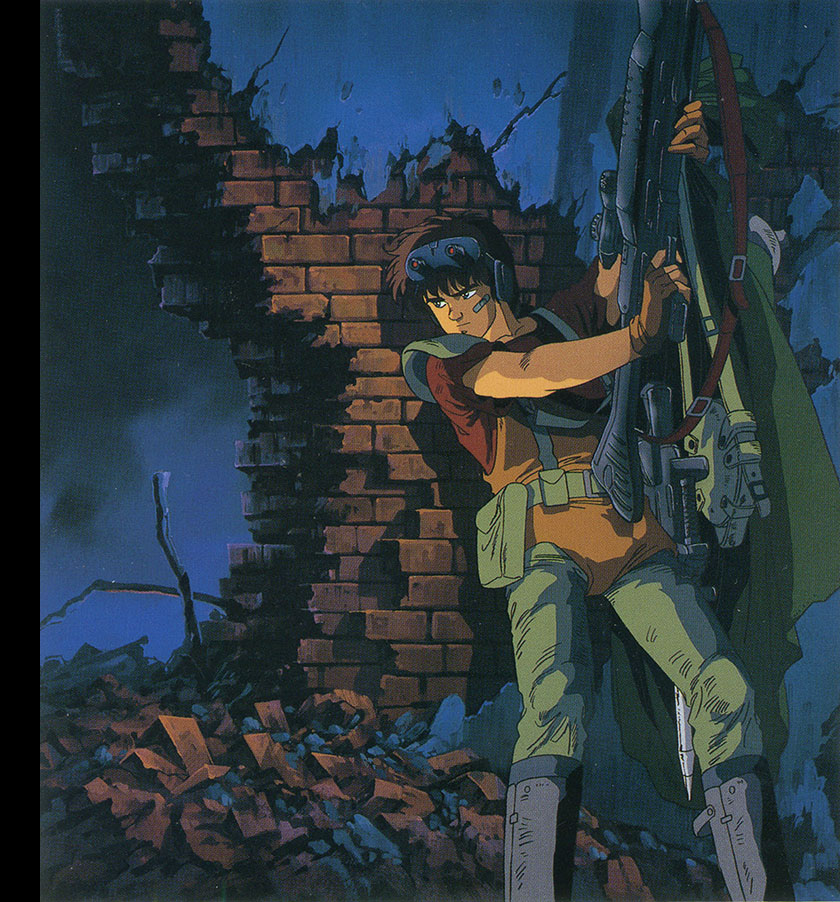Armor Hunter Merowlink staff interviews
Introduction from the DVD box set (released by VAP in 2006)
Explanation
Armor Hunter Merowlink is an OVA series that was released in 6 volumes (12 episodes) from November 1988 to April of the following year. As the title indicates, it was planned as a side story to Armored Trooper Votoms (aired on TV from April ’83 to March the following year).
Many fans were attracted not only by the story and characters of Votoms but also by its worldview. In addition to Merowlink, many novels and games set in the world of Votoms have been published as side stories. However, there are only a few in which the original staff (many of them) participated. The only one that has been produced as anime is Merowlink, even up to the present day (2006).
Merowlink has the characteristics of a Votoms side story, but also attempts a number of ambitious challenges when viewed as a single anime series. The most prominent of these is the “main character who does not pilot a robot.”
Many robot series commercialize the mecha that the main character pilots, allowing them to acquire toy companies as sponsors of a TV broadcast. Therefore, it is inevitable that the robot ridden by the main character would represent the world of the work. (There is no exception in the case of Chirico, even though he does not have a dedicated machine until the end of the series.)
However, there is no need for OVAs to stick to this format. A robot product with pure drama and images as its commercial value was established here. And the staff members, including Ryosuke Takahashi, were able to create a fuller and more complete work with rich depictions of human beings. Many fans were attracted to this aspect of Votoms and Takahashi’s previous series, Fang of the Sun Dougram (broadcast from October 1981 to March 1983), which was directed by Takeyuki Kanda. Merowlink is a continuation of this development.
The protagonist Ality Merowlink has a contradictory charm, showing the true face of a teenage boy while devoting himself to the gruesome goal of revenge. Kiek and Lulucy, as well as each and every one of the minor characters, is attractively portrayed, and this work has gained a wide fan base, even among those who are unfamiliar with Votoms.
In recent years, Votoms has experienced a resurgence in popularity, and a new production is finally in the works. We hope that this box set will allow viewers to fully enjoy this extravaganza that plays a part in the world of Votoms.
All these interviews were conducted in 1994 and published in the Armor Hunter Merowlink LD box set (released by VAP in 1994), then reprinted in the DVD booklet.
See the entire staff list at Anime News Network here.
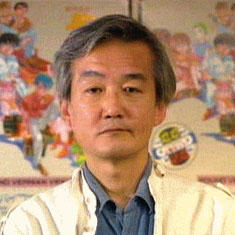
Takeyuki Kanda
Supervising Director
After working at Mushi Pro, he directed The Ultraman, Vifam, Galatt, and Dragonar. He is known for his warm character portrayals and careful depiction of the battlefield. He also directed Deep Blue Fleet and Mobile Suit Gundam, The 08th MS Team. He passed away in 1996 at the age of 52.
See his credit list at Anime News Network here.
Interviewer: I heard that you were nominated by Ryosuke Takahashi to participate in Merowlink.
Kanda: Yes, I was. Ryosuke asked me if I could help him, and I did. I personally was a fan of Combat and other war stories, so I was very satisfied with the work. I felt a great sense of satisfaction. I also storyboarded some of it myself. Among them, I like Battlefield (Ep 5) very much. (Note: Kanda drew storyboards under the penname Yuichiro Yokoyama.)
Interviewer: Was there anything special about it being a Votoms side story?
Kanda: Before accepting this job, I told them that I didn’t know Votoms. I had never even seen the TV series. But they said, “We want you to create your own world with Merowlink.” So, I agreed to it. I really didn’t even know what Votoms was. I don’t know if that turned out to be a good thing or a bad thing. (Laughs)
Interviewer: Which part of this film was mainly the director’s idea?
Kanda: Ryosuke created a kind of perfect character in Votoms, didn’t he? I don’t think there is such a person. Everyone has a weak point or two.
At the beginning of the project, Merowlink was a loner, a lonely character like Golgo 13. (Laughs) But I don’t like that kind of thing. I prefer a character who, when he’s hungry, says “I’m hungry,” and laughs and cries. I like people who are full of such weaknesses. I’m the same way. (Laughs) I also wanted Merow to show human nature, that blood flows when you pierce the skin. I guess that’s about it. I was allowed to do it freely in my own way, and it was fun.
However, there was one problem. I thought Lulucy was a very neutral girl. I thought she should be more charming. Ryosuke wanted to portray her as more mature, a woman who is independent and can handle the world. I think you can see the difference in the way Lulucy is portrayed in the first and second episodes. The first episode shows the Lulucy that Ryosuke wanted to portray. But in the second episode, I used my director’s authority to make her the Lulucy I wanted. (Laughs)
Interviewer: I think the entire series was a brilliant work, wasn’t it?
Kanda: Unlike the TV series, we made it so that the setting changed each episode. The first one was a base episode, the second one was an arena episode. We enjoyed the transition from one episode to the next, which gives it the feel of a serial story.
Interviewer: In the latter half of the film, the story shifted to a continuous story, didn’t it?
Kanda: That was because we wanted to include Ryosuke’s unique sense of solving mysteries.
Interviewer: I think the directing of each episode was also very fulfilling.
Kanda: In this production, there were three directors for all 12 episodes, so it was like a competition. We stimulated each other, so it was a good environment to work in. Also, like the story, the casting of the voice actors added a lot of weight to this work.
Interviewer: Nobuo Tanaka was impressive in Battlefield.
Kanda: That sergeant. That was a parody of Combat that I consciously put in. (Laughs) The staff was also in the same groove, so a lot of parts are conscious of various old movies. (Laughs)
Interviewer: In addition to choosing Mr. Tanaka, you also did a lot of casting, didn’t you?
Kanda: That was the great achievement of the sound director, Mr. Urakami. He brought us some to choose from and said, “What do you think?” Akio Otsuka, who played Kiek, said that was his debut. He was very good.
I’ve known Mr. Urakami for a long time. He demands extremely high quality. He always says, “This person should be able to give a better performance.” If he’s not satisfied with any part of the performance, he asks for more. He is so demanding that we feel sorry for the voice actors. If it were me, I’d say, “That’s enough” at a much earlier stage. (Laughs) I learned a lot from his attitude and dedication to improve the quality of his work.
However, there were no women in the Merowlink studio. When you stepped into the studio, it was full of guys. That was probably my only regret. (Laughs)
Interviewer: Merowlink was very high quality, but wasn’t it a lot of work to make all 12 episodes in six months?
Kanda: That’s one of the great things about Sunrise. There’s a kind of competition between production and direction. If it had been any other production company, they would have said, “Please stop! Instead of animating this, just show a single moving picture!” I’m thankful to the producers for their hard work.
Interviewer: You and Ryosuke Takahashi have been working together for quite a long time, haven’t you?
Kanda: Ryosuke was a year ahead of me at Mushi Pro (Osamu Tezuka’s studio). We’ve been friends since we worked on a black and white anime called Wonder Three. The first time I co-directed with him was for Dougram. That was also a lot of fun to work on. Kunio Okawara was the mecha designer for that, as he was for Votoms and Merowlink. I was always angry about how badly the robots were treated. (Laughs)
Interviewer: There were more scenes of Dougram being carried around on a trailer than fighting.
Kanda: Yes, because the robots were just in the way. (Laughs) But it was a fun job, because I was able to depict the drama of the people in great detail. For Dougram, Ryosuke did the script and I was the visual director, the same as on Merowlink.
He and I are often referred to as a team. But we had a sense of rivalry, like, “If the script is this good, I have to make the visuals just as good, or I lose.” It was always tiring, but it was satisfying work. It was the same with Merowlink. Because we know each other so well, we know what the other person is trying to say. I can understand what’s written between the lines of the script.
Interviewer: Battlefield was written by Ryosuke Takahashi, wasn’t it?
Kanda: In that episode, he wrote even fewer lines than usual. (Laughs) But we’ve known each other for a long time, and as I said before, I know what’s written between the lines.
I’ve never been to war, so I don’t really know what it’s like, but I struggled to capture the smell of gunpowder, smoke, and a realistic atmosphere of the battlefield. I also paid attention to the atmosphere inside the bunker and other such details. We had to depict a lot things to create the atmosphere. Even though there wasn’t much in that script, it wasn’t a problem. The storyboards for that episode came out very quickly. (Laughs)
Interviewer: Lastly, could you give a message to the fans who are seeing Merowlink again?
Kanda: I didn’t prepare a message, so I’m at a loss. (Laughs) I think it was a very interesting story, and even after watching it two, three, or four times, you will discover something new. “Yes, they wanted to say something like this.” So please don’t just watch it once.
I think it’s a work with a lot of flavor. I think you’ll come to love the characters and mecha no matter how many times you see it. I guess that’s the nature of Ryosuke Takahashi’s works.
Moriyasu Taniguchi
Character Design / Animation Director
After working as a designer of Nishijin textiles and at a commercial film production company, Taniguchi became active as an animator. He has trained many talented animators at Anime All, one of the leading animation studios in Kansai, which he runs. He was in charge of character design for SPT Layzner and Galaga.
See his MASSIVE credit list at Anime News Network here.
Interviewer: How did you come to be involved in this work?
Taniguchi: I participated in the Votoms TV series, and at that time, the director Mr. Takahashi, said to me, “Let’s work together again.” That’s how I got the call.
Interviewer: How much of the content had been decided by the time you joined?
Taniguchi: Except for the fact that it was an offshoot of Votoms, nothing had been decided. I was told, “Just draw any character you like.” So I drew a character I liked, but Merowlink is 17 years old, and I was told that my design looked about 25. (Laughs) I redrew the character many times and finally came close to what other people thought was a 17 year old. You can design a character before the story is solidified, and you can talk about it in the meantime, working out various things in the process. It’s a nice way to make a film, isn’t it?
Interviewer: What were your orders when designing Merowlink?
Taniguchi: I was told not to make him too “pretty.” Did I say that? (Laughs) Anyway, I tried not to make the main character handsome.
Interviewer: I heard that the design of the bandage was your idea.
Taniguchi: Yes, that’s right. (Laughs) I was sometimes asked, “Do you really want to put that on him?” But I forced them to put it on. I like it.
Interviewer: How about Kiek?
Taniguchi: Kiek was the first one I created because the character description was clear. Then nothing was said, and it was decided as it was.
Interviewer: That’s very unusual, isn’t it?
Taniguchi: That’s right. But the director, Kanda-san, and I had a hard time finding the right image for the sub-characters in each episode. It was the first time for me to work with him, so it took a long time to unify the images.
Interviewer: Did you know from the beginning that Kiek was going to play the antagonist?
Taniguchi: No, I had not heard that at all. When I heard he would be the last enemy, I thought it was interesting.
Interviewer: How do you like Lulucy?
Taniguchi: She’s a character that required a more mature performance than I first thought. I thought afterward that she was a bit childish or innocent.
Interviewer: Who is your favorite sub-character?
Taniguchi: Gorfi from Leaning Tower (Ep 4). I like that one. He was one of the sub-characters that came through easily, and fit perfectly for the director. I also like Vance because I think I was able to bring out the unpleasantness of his character. I was impressed by that.
Interviewer: Boyle was also a popular character, wasn’t he?
Taniguchi: Kanda-san said, “It doesn’t matter if the drawing of the face is a bit off, just give us a tough guy.” The face is a little too much for the skull (Laughs), but I thought it would be better that way.
Interviewer: Now, please tell us about the episode that left a particularly strong impression on you.
Taniguchi: I would have to say the episode about Gorfi. It was the most interesting and unusual episode. The characters aren’t shown very often, so we had to be visually creative. It was also challenging to create visually. The other day, I was rewatching the episode for the first time in a while to draw a jacket illustration, and I thought, “Hey, that’s pretty good.”
Interviewer: How do you like working with Ryosuke Takahashi?
Taniguchi: If he were to create a work from scratch with no restrictions, I think he’d make something even more interesting than what he’s done so far. I respect him a lot. (Laughs) I also like the Votoms world. It’s the most fun to work on. There are fewer such works these days, so it’s a little sad.
Interviewer: How was the response from fans?
Taniguchi: I often received doujinshis related to Merowlink. Compared to my other work, the quantity is much larger. There are especially a lot of women who make them. I thought this was a work for men. (Laughs) Sometimes there are people who draw better than me. I look at them and think, “How good they are!” (Laughs)
Interviewer: Lastly, please tell us what you would like us to pay attention to.
Taniguchi: Let’s see. The director worked very hard on this piece, so it’s very well produced down to the smallest detail. Not only the story, but also the camera work, and even the small things on the edge of the screen. You can’t see that in today’s TV series and videos. If you see those things, you can tell that we spent a lot of time to make this film, even under a tight schedule.
Hiroshi Yamaguchi
Scriptwriter
After working as an animator and editor, he made his debut as a screenwriter with Armor Hunter Merowlink. His representative works since then include Akazukin Chacha, Evangelion, Gaogaigar, Gate Keepers, Komitsu Party, Desert Punk, Sergeant Frog, and many others. He also directed the original story for the OVA Gate Keepers 21.
See his credit list at Anime News Network here.
Interviewer: How did you come to be involved in this work?
Yamaguchi: I had written a Votoms game book called Planet of Vengeance Shido (below left). Ryosuke Takahashi remembered my name from a magazine interview. He told me, “I’m going to do a project called Merowlink.” I had never written a script at that time, so I was wondering whether it was a good idea or not. Now I think that Ryosuke had a lot of guts. (Laughs)
Interviewer: You were in charge of the largest number of episodes among the participants.
Yamaguchi: That’s right. I think it was due to the schedule, but I didn’t think I would have to do five episodes. However, I insisted on writing the last episode.
Interviewer: How far had the project progressed by the time you joined?
Yamaguchi: The basic story and characters were already in place, and Taniguchi’s rough drafts were in the process of being completed. At that point, Ryosuke explained to me that he wanted to make a complete story with self-contained episodes. In this episode a spaceship is destroyed. In this one a train is destroyed, and so on. The concept was to do in one episode what was done in Votoms over the course of one arc. I like that kind of story, so I tried to do it faithfully in the scripts I was in charge of.
The first sample story I was given was the prototype for Prison (Ep 6). I was asked to come up with several plots, and I wrote three or four premises. In the end, Colosseum (Ep 2) and Leaning Tower (Ep 4) were chosen from among them. For those two episodes, I wrote the scripts without changing much from the first plot.
For Colosseum, I first came up with the idea of a human vs. an AT in Battling. For Leaning Tower, I thought it would be interesting to have a fight in a high, enclosed space.
Interviewer: It was a unique story in that only Merow, Kiek, and Gorfi appeared.
Yamaguchi: Some thought it would be better if Lulucy appeared, but Ryosuke said, “I think this kind of story will please the fans, so it’s okay if she doesn’t.” I remember a year or two later, I saw Die Hard and said, “Oh, they’re doing the same thing.” (Laughs) I’m particularly attached to episodes 2 and 4, because they’re stories that I created from the plot on up.
Interviewer: I heard that you also came up with various ideas for mecha.
Yamaguchi: Yes, I wanted to tell a story in which mecha specs and the script came together as one. Votoms itself was a work that fully utilized the mecha specs. The Bountydog, for example, was designed by Mr. Okawara from a large rough sketch I drew. When I think about it now, I feel that I did a fearful thing. (Laughs)
Interviewer: How do you like the 7th episode, Railway?
Yamaguchi: At first, I was thinking of a story that takes place only on a train. I wanted to have a Hitchcock-like atmosphere. Later, it ended up going outside the train. Episode 7 had the biggest change from the plot. That was the first time Ryosuke told me that Kiek was actually an enemy. From that episode, the story became continuous, and I wrote it with that in mind.
Interviewer: I think the ending of the final episode was quite a good idea.
Yamaguchi: It was decided from the beginning to end the story rather simply. Takashi Imanishi was the director of the last episode, and he did a lot of elaborate things. It’s one of my favorites, along with Leaning Tower.
At first, Merow and Kiek were supposed to fight away from the base. I really wanted them to fight on the base as missiles were launching upward. The producer, Mr. Sashida, was worried that it would be difficult to depict, but I was able to do what I wanted. (Laughs) Ryosuke was very particular about the conversation between Merow and Kiek in the final battle. He made a lot of changes to the dialogue.
I also tried to elaborate on the science fiction concepts for that story, such as orbital detonation mines and base interceptor shifts. The term “jamming from orbit” was not in common use at the time. Mr. Imanishi is also a fan of such things, so I was very happy that he was able to depict it well. Oh, by the way, the fact that Commander Gilman goes crazy at the end was not in the script. It was Mr. Imanishi who added that. (Laughs) But it was an ideal final episode for what I think of as a robot anime.
Interviewer: The scene where Merow is called “avenger” by the soldiers at the base was impressive.
Yamaguchi: That was also due to my selfishness. Merow has killed many people in the process of revenge. I couldn’t agree with that, so I wanted to make a clear distinction. I really wanted to show that if you kill people, your enemies may think of you as an avenger. I really wanted to show that.
There was also talk about whether or not to reduce the scale, but I was still selfish about it. Ryosuke said it would be okay, so everything was included and I have no regrets. When I think about it now, I wonder how a person who had never worked on a script before could get away with so much.
Interviewer: Please give a message to the people who will see this series.
Yamaguchi: As a scriptwriter, I hope you enjoy the story itself as well as the flashy mecha action and other aspects of the artwork. (Laughs) I think this work is easier to watch than Votoms for casual fans.
Eiji Sashida
Producer
After working for Sunrise Music Publishing, Eiji Sashida became an active producer at Sunrise. He produced works such as the Dirty Pair OVA series, the Patlabor TV series, The Big O, Wataru, and many more.
See his credit list at Anime News Network here.
Interviewer: Can you tell us about the start of this project?
Sashida: To be exact, when I was thinking of producing a video work as Sunrise, I was inspired by Ryosuke Takahashi’s idea and the producers’ desire to do a Votoms side story. Ryosuke is a fan of war stories like Soldier Yakuza and Independent Fool’s Regiment, so that was a big part of it.
Interviewer: So you planned it for the home video format from the beginning.
Sashida: Of course, yes. But we also wanted to make it into a series. That’s why we wanted different stories and different ways of presenting them (for video and TV). However, I thought it would be difficult to make this into a TV series. (Laughs)
Interviewer: Compared to Votoms, Merowlink has a lot more female fans. Were you conscious of that?
Sashida: Among our staff, we were aware that Votoms didn’t have many female fans. So of course we were aware of a wider possible target audience. But we didn’t make it especially for female fans.
Interviewer: How did you decide on the other staff members?
Sashida: Ryosuke Takahashi appointed Takeyuki Kanda, Moriyasu Taniguchi, and Takashi Imanishi. Ryosuke had a clear idea in his mind that if we combined these three, we could create this kind of work.
Except for Mr. Kanda, many of the other members had Votoms experience: Taniguchi, Imanishi, Composer Hiroki Inui, Mecha Designer Kunio Okawara, and Sound Supervisor Yasuo Urakami.
Interviewer: How was Inui-san’s music?
Sashida: No one else could create the music for Merowlink without destroying the world of Votoms. He never deviates from that unique natural sound we were looking for. He created the very sound we wanted.
Interviewer: I think the staff as well as the cast members were all extravagant.
Sashida: Mr. Urakami’s casting was amazing, wasn’t it? I was impressed by the choice of Akio Otsuka. (Laughs) Like Hozumi Goda [Chirico] in Votoms, the people Mr. Urakami brings in are amazing.
Interviewer: It must have been very difficult to produce such a high quality product on such a tight schedule.
Sashida: It was really well done. Ryosuke and the rest of the staff were very particular about the quality of their work, so it was tough. Simply put, it’s always a matter of time and money…
Interviewer: Which part was particularly difficult?
Sashida: Everything. From the script to the direction and the art. However, there are many points to reflect on. I think we went over the line to a certain extent. I wish we could have worked harder on the parts that Mr. Ryosuke and Mr. Kanda were aiming for.
Interviewer: Which episode left the greatest impression on you?
Sashida: Leaning Tower is very good. The other one is Last Stage (Ep 12). Kiek was great. The showdown between Kiek and Merow at the end was really good.
Interviewer: The ending of Last Stage was impressive in the way it cut off the lingering echoes.
Sashida: I was conscious of that. It’s not a work that ends with a big musical climax. The composition of the 12 episodes was not fully worked out from the beginning. As we were working on it, we decided that the last one had to be like that.
Interviewer: Is it difficult to broadcast this type of work on TV?
Sashida: There are too many restrictions with TV, so OVA is the most suitable. It’s a medium that allows the author to include as much of what he wants to do as possible. There are still many things I’d like to do with Merowlink. I’d like to try it again if I could. A protagonist with a clear objective has a strong presence and is worth watching. If possible, I’d like to make a longer film. I think it would be interesting to take a closer look at Merow as a human being. He’s a good character.
Interviewer: What part would you like fans to pay attention to in this box set?
Sashida: This will sound funny, but it’s the booklet. I wanted a booklet like this. The video content is unchanged, so I hope you’ll enjoy the world of Merow more deeply with the various extras.

